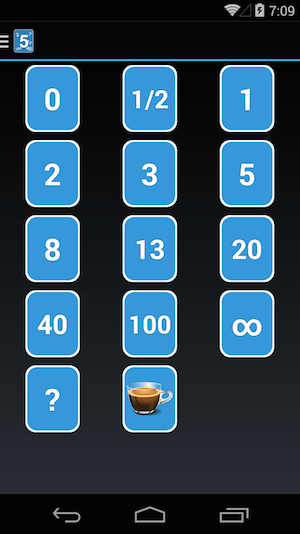
In the previous article, you’ll find a definition of the Epics, Stories and Tasks, plus how the fit into the Backlog and Sprints.
This article will focus on story sizing. The main points are:
- Use the Fibonacci sequence: 1, 2, 3, 5, 8, 13, 21
- SM and Contributors vote to quickly size stories
- Relative sizing in a fun social game is as effective as in depth analysis, in a fraction of the time.
Story sizing is done by the SM and the Contributors together. Use the Fibonacci sequence; each story is size 1, 2, 3, 5, 8, 13 or 21. The size of stories is based on complexity, not hours. Each team will naturally gravitate towards a common understanding of the level of complexity each number in the Fibonacci sequence represents. It’s a little rough at first, but after a few Sprints, everyone is in sync.
13 and 21 have special meaning. 21 is reserved for meaning this story is either too big to size accurately or the acceptance criteria is not yet defined well enough to size. A 21 point story cannot be pulled into a Sprint or have it’s tasks defined. 13 is an accurate size with well defined acceptance criteria, but should probably be broken up into multiple stories.
The Scrum Poker Game
For story sizing, in a meeting where all or most of the team members are present, a story’s acceptance criteria is explained. Q&A continues until all team members are ready to vote. Often playing cards are used, but fingers work just fine too. You say, “Everyone ready? (wait until everyone is). Ok, on the count of 3. 1, 2, 3, vote”. Everyone holds up their number. Repeat until all the stories are sized.
Scrum Poker Apps
There are many Scrum Poker Apps like this one:
These apps can provide a fun way for team members to select their story size vote when there aren’t enough analog cards to go around, or just because its trendy.
How to select size after the vote
If everyone votes within one Fibonacci number of each other, the higher number is taken. No more discussion is needed.
If any votes are more than one Fibonacci number apart, take turns explaining the high and low values. If the low vote is willing to come up or the high vote is willing to come down, so all the votes are within one Fibonacci number apart, then the previous rule can play and sizing is done. Sometimes a revote is needed.
Outcome
This relative story sizing technique is fast and is usually good enough of an estimate. It puts emphasis on getting going with the Sprint, and less on super accurate time estimates. With practice, you’ll find this sizing technique with the Fibonacci numbers to be as accurate as in depth analysis, in a fraction of the time. Making it a social game adds an element of fun to it. The team will appreciate the lightweight approach and many will look forward to the exercise.
In the next article, will explain the dos and don’ts of the Sprint, where the work is done and the value is created.
